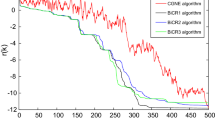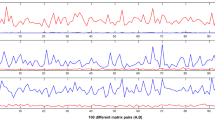Abstract
This paper is concerned with the least squares inverse eigenvalue problem of reconstructing a linear parameterized real symmetric matrix from the prescribed partial eigenvalues in the sense of least squares, which was originally proposed by Chen and Chu (SIAM J Numer Anal 33:2417–2430, 1996). We provide a geometric Gauss–Newton method for solving the least squares inverse eigenvalue problem. The global and local convergence analysis of the proposed method is established under some assumptions. Also, a preconditioned conjugate gradient method with an efficient preconditioner is proposed for solving the geometric Gauss–Newton equation. Finally, some numerical tests, including an application in the inverse Sturm–Liouville problem, are reported to illustrate the efficiency of the proposed method.

Similar content being viewed by others
References
Absil, P.-A., Baker, C.G., Gallivan, K.A.: Trust-region methods on Riemannian manifolds. Found. Comput. Math. 7, 303–330 (2007)
Absil, P.-A., Mahony, R., Sepulchre, R.: Optimization Algorithms on Matrix Manifolds. Princeton University Press, Princeton (2008)
Absil, P.-A., Malick, J.: Projection-like retractions on matrix manifolds. SIAM J. Optim. 22, 135–158 (2012)
Adler, R.L., Dedieu, J.-P., Margulies, J.Y., Martens, M., Shub, M.: Newton’s method on Riemannian manifolds and a geometric model for the human spine. IMA J. Numer. Anal. 22, 359–390 (2002)
Barrett, W., Butler, S., Fallat, S.M., Hall, H.T., Hogben, L., Lin, J.C.-H., Shader, B.L., Young, M.: The inverse eigenvalue problem of a graph: multiplicities and minors. arXiv:1708.00064 (2017)
Barrett, W., Nelson, C.G., Sinkovic, J.H., Yang, T.: The combinatorial inverse eigenvalue problem II: all cases for small graphs. Electron. J. Linear Algebra 27, 742–778 (2014)
Bernstein, D.S.: Matrix Mathematics-Theory, Facts, and Formulas, 2nd edn. Princeton University Press, Princeton (2009)
Bertsekas, D.P.: Nonlinear Programming, 2nd edn. Athena Scientific, Belmont (1999)
Brussaard, P.J., Glaudemans, P.W.M.: Shell Model Applications in Nuclear Spectroscopy. North-Holland Publishing Company, Amsterdam (1977)
Chen, X.Z., Chu, M.T.: On the least-squares solution of inverse eigenvalue problems. SIAM J. Numer. Anal. 33, 2417–2430 (1996)
Chu, M.T.: Inverse eigenvalue problems. SIAM Rev. 40, 1–39 (1998)
Chu, M.T., Driessel, K.R.: Constructing symmetric nonnegative matrices with prescribed eigenvalues by differential equations. SIAM J. Math. Anal. 22, 1372–1387 (1991)
Chu, M.T., Golub, G.H.: Structured inverse eigenvalue problems. Acta Numer. 11, 1–71 (2002)
Chu, M.T., Golub, G.H.: Inverse Eigenvalue Problems: Theory, Algorithms, and Applications. Oxford University Press, Oxford (2005)
Chu, M.T., Guo, Q.: A numerical method for the inverse stochastic spectrum problem. SIAM J. Matrix Anal. Appl. 19, 1027–1039 (1998)
Coleman, R.: Calculus on Normed Vector Spaces. Springer, New York (2012)
Cox, S.J., Embree, M., Hokanson, J.M.: One can hear the composition of a string: experiments with an inverse eigenvalue problem. SIAM Rev. 54, 157–178 (2012)
Dai, H., Bai, Z.Z., Wei, Y.: On the solvability condition and numerical algorithm for the parameterized generalized inverse eigenvalue problem. SIAM J. Matrix Anal. Appl. 36, 707–726 (2015)
Dalmolin, Q., Oliveira, R.: Inverse eigenvalue problem applied to weight optimisation in a geodetic network. Surv. Rev. 43, 187–198 (2011)
Datta, B.N.: Numerical Methods for Linear Control Systems: Design and Analysis. Elsevier Academic Press, London (2003)
Dennis, J.E., Schnabel, R.B.: Numerical Methods for Unconstrained Optimization and Nonlinear Equations. Prentice-Hall, Englewood Cliffs (1983)
Friedland, S.: The reconstruction of a symmetric matrix from the spectral data. J. Math. Anal. Appl. 71, 412–422 (1979)
Friedland, S., Nocedal, J., Overton, M.L.: The formulation and analysis of numerical methods for inverse eigenvalue problems. SIAM J. Numer. Anal. 24, 634–667 (1987)
Friswell, M.I., Mottershead, J.E.: Finite Element Model Updating in Structural Dynamics. Kluwer Academic Publishers, Dordrecht (1995)
Gladwell, G.M.L.: Inverse Problems in Vibration. Kluwer Academic Publishers, Dordrecht (2004)
Golub, G.H., Van Loan, C.F.: Matrix Computations, 4th edn. Johns Hopkins University Press, Baltimore (2013)
Gratton, S., Lawless, A.S., Nichols, N.K.: Approximate Gauss–Newton methods for nonlinear least squares problems. SIAM J. Optim. 18, 106–132 (2007)
Hager, W.W.: Updating the inverse of a matrix. SIAM Rev. 31, 221–239 (1989)
Hald, O.H.: The inverse Sturm–Liouville problem and the Rayleigh–Ritz method. Math. Comput. 32, 687–705 (1978)
Helmke, U., Moore, J.B.: Optimization and Dynamical Systems. Springer, London (1994)
Hogben, L.: Spectral graph theory and the inverse eigenvalue problem of a graph. Electron. J. Linear Algebra 14, 12–31 (2005)
Horn, R.A., Johnson, C.R.: Topics in Matrix Analysis. Cambridge University Press, Cambridge (1994)
Ring, W., Wirth, B.: Optimization methods on Riemannian manifolds and their application to shape space. SIAM J. Optim. 22, 596–627 (2012)
Saad, Y.: Iterative Methods for Sparse Linear Systems, 2nd edn. SIAM, Philadelphia (2003)
Smith, S.T.: Optimization techniques on Riemannian manifolds. In: Bloch, A. (ed.) Hamiltonian and Gradient Flows, Algorithms and Control. Fields Institute Communications, vol. 3, pp. 113–136. AMS, Providence (1994)
Singh, K.V.: Transcendental inverse eigenvalue problems in damage parameter estimation. Mech. Syst. Signal Process. 23, 1870–1883 (2009)
Singh, K.V., Ram, Y.M.: A transcendental inverse eigenvalue problem associated with longitudinal vibrations in rods. AIAA J. 44, 317–332 (2006)
Tao, G.W., Zhang, H.M., Chang, H.L., Choubey, B.: Inverse eigenvalue sensing in coupled micro/nano system. J. Microelectromech. Syst. 27, 886–895 (2018)
Toman, S., Pliva, J.: Multiplicity of solutions of the inverse secular problem. J. Mol. Spectrosc. 21, 362–371 (1966)
Tropp, J.A., Dhillon, I.S., Heath, R.W.: Finite-step algorithms for constructing optimal CDMA signature sequences. IEEE Trans. Inf. Theory 50, 2916–2921 (2004)
Wang, Z.B., Vong, S.W.: A Gauss-Newton-like method for inverse eigenvalue problems. Int. J. Comput. Math. 90, 1435–1447 (2013)
Wolf, M.M., Perez-Garcia, D.: The inverse eigenvalue problem for quantum channels. arXiv:1005.4545 (2010)
Xu, S.F.: An Introduction to Inverse Algebraic Eigenvalue Problems. Peking University Press, Beijing (1998)
Yao, T.T., Bai, Z.J., Zhao, Z., Ching, W.K.: A Riemannian Fletcher–Reeves conjugate gradient method for doubly stochastic inverse eigenvalue problems. SIAM J. Matrix Anal. Appl. 37, 215–234 (2016)
Zhao, Z., Bai, Z.J., Jin, X.Q.: A Riemannian Newton algorithm for nonlinear eigenvalue problems. SIAM J. Matrix Anal. Appl. 36, 752–774 (2015)
Zhao, Z., Bai, Z.J., Jin, X.Q.: A Riemannian inexact Newton-CG method for constructing a nonnegative matrix with prescribed realizable spectrum. Numer. Math. 140, 827–855 (2018)
Zhao, Z., Jin, X.Q., Bai, Z.J.: A geometric nonlinear conjugate gradient method for stochastic inverse eigenvalue problems. SIAM J. Numer. Anal. 54, 2015–2035 (2016)
Acknowledgements
We are very grateful to the editor and the referees for their valuable comments and suggestions, which have considerably improved this paper.
Author information
Authors and Affiliations
Corresponding author
Additional information
Communicated by Michiel E. Hochstenbach.
Publisher's Note
Springer Nature remains neutral with regard to jurisdictional claims in published maps and institutional affiliations.
This work was supported by NSFC Nos. 11701514, 11671337, 11601112. The research of Z. J. Bai was partially supported by the Fundamental Research Funds for the Central Universities (No. 20720180008). The research of X. Q. Jin was supported by the research grant MYRG2016-00077-FST from University of Macau.
Appendix A
Appendix A
In this appendix, we deduce (2.4) and (2.6). To derive the Riemannian differential of \(H:\mathscr {Z}\rightarrow \mathbb {SR}^{n\times n}\) defined by (2.2), we consider the following extended mapping
which is defined by
for all \((\mathbf {c}, Q, \varLambda )\in \mathbb {R}^{l} \times \mathbb {R}^{n\times n} \times \mathscr {D}(n-m)\), where \(\overline{\varLambda }\) is defined as in (2.1). Thus the map H is the restriction of \(\widetilde{H}\) from the Euclidean space \(\mathbb {R}^{l} \times \mathbb {R}^{n\times n} \times \mathscr {D}(n-m)\) to the Riemannian product manifold \(\mathscr {Z}\), i.e., \(H =\widetilde{H}|_{\mathscr {Z}}\).
Similar to [2, (3.17)], for any \((\varDelta \mathbf {c},\varDelta Q, \varDelta \varLambda ) \in T_{(\mathbf {c},Q,\varLambda )}\mathscr {Z}\), one has
For a tangent vector \((\varDelta \mathbf {c},\varDelta Q, \varDelta \varLambda ) \in T_{(\mathbf {c},Q,\varLambda )}\mathscr {Z}\), the matrix \(\varDelta QQ^T\) is skew-symmetric [2, (3.26)], i.e.,
By the definition of P in (2.5) we have
Using (2.1), (2.5), (A.1), (A.3), and (A.4) we have
where \(t\in {\mathbb {R}}\). Based on Proposition 2.5 in [16] and the above equality, we have
This, together with (A.2), yields
for all \((\mathbf {c}, Q, \varLambda )\in \mathscr {Z}\) and \((\varDelta \mathbf {c},\varDelta Q, \varDelta \varLambda ) \in T_{(\mathbf {c},Q,\varLambda )}\mathscr {Z}\), and thus (2.4) holds.
Let \((\mathbf {c}, Q, \varLambda )\in \mathscr {Z}\). For the Riemannian differential \(\mathrm {D}H(\mathbf {c},Q,\varLambda )\) and its adjoint \((\mathrm {D}H(\mathbf {c},Q,\varLambda ))^*\) with respect to the Riemannian metric g, one has [2, p. 185],
for any \((\varDelta \mathbf {c},\varDelta Q, \varDelta \varLambda ) \in T_{(\mathbf {c},Q,\varLambda )}\mathscr {Z}\) and \(\varDelta Z \in T_{H(\mathbf {c},Q,\varLambda )}\mathbb {SR}^{n\times n}\). Using (3.36) in [2], the definition of the linear operator \(\mathbf {v}\) in (2.7), (A.5), and (A.6) we have
where \(\mathrm{skew}(A):=\frac{1}{2}(A-A^T)\). Thus,
for all \(\varDelta Z \in T_{H(\mathbf {c},Q,\varLambda )}\mathbb {SR}^{n\times n}\). This proves (2.6).
Rights and permissions
About this article
Cite this article
Yao, TT., Bai, ZJ., Jin, XQ. et al. A geometric Gauss–Newton method for least squares inverse eigenvalue problems. Bit Numer Math 60, 825–852 (2020). https://doi.org/10.1007/s10543-019-00798-9
Received:
Accepted:
Published:
Issue Date:
DOI: https://doi.org/10.1007/s10543-019-00798-9




